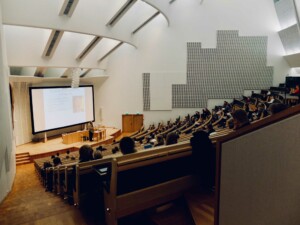Design is everywhere, from the cluster of satellites in low Earth orbit to the clasp of your AirPods case. What isn’t as widespread is thoughtful media about the impacts of design on our lives.
While architecture school or design degrees are valuable educational experiences for those obsessed with design, they’re not the only ones. Now more than ever, a critical and holistic lens for understanding design is urgent. New York’s School of Visual Arts (SVA) is home to one of the most energetic pathways available to those looking for something a little different or more specialized: D-Crit, or Design Research, Writing and Criticism.
If you are someone who actively follows design discourse, chances are you regularly encounter work by D-Crit’s robust community. The two-semester master’s program launched in 2008 and already has alums all over the world. Matt Shaw, AN’s former executive editor, went through the program a decade ago, among others who are now leaders at companies, magazines, and publishers.
Molly Heintz, founder of the editorial consultancy Superscript, has served as program chair and a faculty member since 2015. She said the special sauce is the unique combination of humanities-based critical thinking and journalistic skills.
“We train our students to bring PhD-level rigor to their research and analysis, but then give them the tools to communicate that work in an engaging way to a broad audience,” Heintz told AN. “If we start by considering something through the lens of design, it allows us to ask the best questions that ultimately get at urgent social issues and cultural trends.”
Next fall, the master’s program will also pilot a part-time schedule for working professionals. Applications are due by January 15 and accepted students receive an average of $25,000 in scholarship funding. Those attending an upcoming online information session on Tuesday, January 9, at 7 p.m. will have their application fee waived.
In advance of the deadline, we asked a handful of D-Crit alums and faculty to decode how the program has expanded critical discourse around design. AN spoke with graduates Clara Gross, a Berlin-based artist, writer, and researcher; Brooke Viegut, who merges design with her theater and performance practice; and Matt Shaw, a New York–based author, editor, curator, and teacher. AN also heard from current faculty Alicia Olushola Ajayi, an architectural designer, researcher, and writer based in New York and Los Angeles who is also a D-Crit alumna; and Karrie Jacobs, formerly an architecture critic at New York Magazine, Metropolis columnist, and founding editor-in-chief at Dwell, among other roles.

AN: What drew you to SVA’s D-Crit program? What were you seeking, and what did you find?
Matt Shaw: As an undergrad in architecture school, I had been running a blog called Mockitecture, which was like a proto-meme page. It was a tiny part of the golden era of blogs that included people like Charles Holland, Sam Jacob, Owen Hatherley, Ruth Lang, Pedro Gadanho, and Alexandra Lange. At some point, Lange shared D-Crit’s website, which looked totally wacky at the time.
Upon closer review, I saw that there was a community of people in New York who were discussing architecture and design for a living and thought that might be a good community to get involved with. The professors all had very distinguished “practices” as professional journalists, writers, curators, etc. Once I realized that this was a viable professional option, I applied.
I found exactly that: a group of faculty, alumni, and students who were involved in every possible way in the professional design world. I find it very interesting that SVA started as a commercial cartooning school as it’s so connected to the creative world in New York. One long-standing SVA tradition is that each professor is required to be a practitioner.
Clara Gross: When the COVID-19 pandemic hit I was at a point in my career where I wanted to make changes and level up my skills. I am naturally a research-based creative, so I was amassing information and ideas but didn’t have an outlet for it outside of a visual arts practice. Mentally I pictured myself holding stacks of books and papers in my arms without anywhere to put them down, and D-Crit helped me do that. More than anything, I came away from the program with a research method that I’ve been able to channel into writing, research projects, exhibitions, and events.
AN: What did D-Crit offer in contrast to more traditional journalism or research pathways?
Alicia Olushola Ajayi: Freedom! What’s so appealing about D-Crit is its ability to tap into any type of media content with the same type of rigor as a more traditional pathway. Students can spend valuable, concentrated time on their interests and take them in almost any direction they choose as long, as it is substantive. Many students come out of the program with enough significant work to pursue a book deal or an exhibition.
Brooke Viegut: A degree at D-Crit is an investment in process. I always like to say it’s a crash course in thinking about thinking about design. Rather than a journalism degree designed to create reporters or a more traditional researcher, the program is designed to emphasize a holistic understanding of design and its impact.
AN: Did the program or faculty have a lasting impact on your work—either during your time at D-Crit or in work following graduation?
Brooke Viegut: Absolutely! D-Crit’s impact has lasted far beyond graduation. It allowed me to develop a community, as I fell into an energetic, impassioned, intelligent collection of alumni continuing to work in design. Faculty have become friends and mentors, others have become peers, and my classmates are some of my dearest collaborators and sounding boards. Coming from all different areas of design, we find commonality in our curiosity.
It also transformed my practice, encouraging me to continue to ask questions of everything I do and develop a design process that considers the consequences of my work. Those conversations make me, and arguably the industry, better for exploring the bounds of innovation.

AN: Can you tell us about a student or class/seminar that had a lasting impact on your work?
Karrie Jacobs: Every semester I learn new things; it’s part of why I teach. Sometimes I learn from the guests I invite—local architects, designers, and policy makers—but more often from the students themselves. For example, after walking Billionaire’s Row on West 57 Street, one of them gave an in-class presentation about the use of terra-cotta on SHoP’s 111 W. 57th. I was amazed to find out how the traditional ceramic cladding had been transformed into a high-tech material. Another student, in response to an assignment to find a beautiful object at a Jack’s 99 Cent Store, showed up in class with a roll of duct tape and spoke passionately and persuasively about it, as a work of minimalist sculpture: a Serra in miniature. My assumption is that if I learn something from every class session, the students are learning, too.
AN: Why is it important for design criticism to have a strong foundation today?
Karrie Jacobs: We’re at a precipitous moment in the history of the planet, and one of the ways we got here is by being uncritical (and uncurious) about design. Whether it’s the design of massive systems (like highway networks or 100-mile-long cities), or seemingly innocuous things like facial scrubs composed of tiny plastic beads, we can’t afford to look away from the objects and systems all around us. We can’t simply accept that designers, architects, developers, manufacturers, technologists, and politicians know what they’re doing, or will learn from past mistakes. Design criticism is the discipline of thinking critically about the things we mostly take for granted… and we can no longer risk taking anything for granted.
Alicia Olushola Ajayi: There is a lot of discourse in architecture that suggests criticism is dying or already dead. But I think this outcry for the loss of criticism is coded, and what’s really being said is that criticism no longer represents the canon that gatekeeps certain approaches, perspectives, and people out of the architecture world.
Design criticism is not dead, but changing to be more inclusive, more critical, and more encompassing, and this is more important than ever. We are seeing that criticism can help shape more equitable approaches to design as it shifts away from the surface-level exercise of “this building bad and that architect good.” Programs like D-Crit teach students how to look outside traditional narratives and create truer and more accessible systems, things, and ideas that encourage the public to participate in the betterment of our world.











